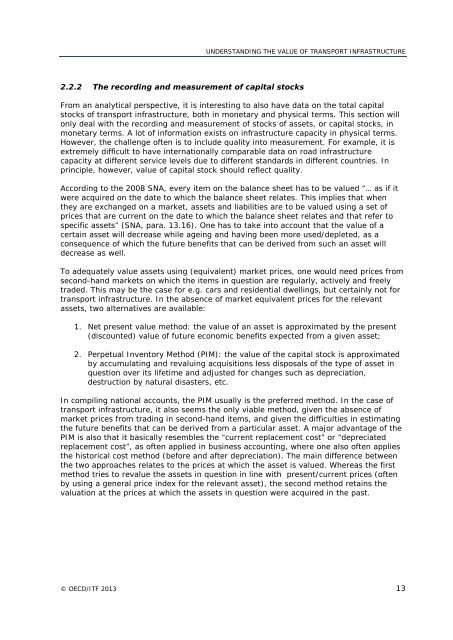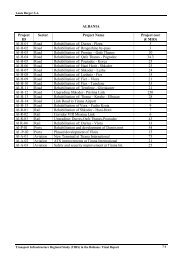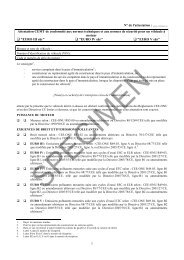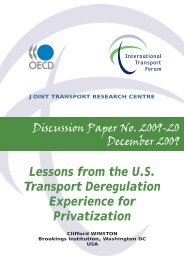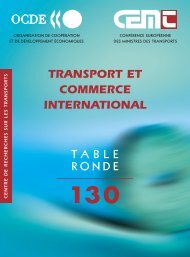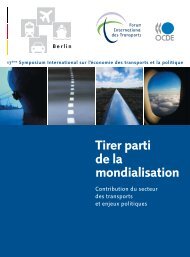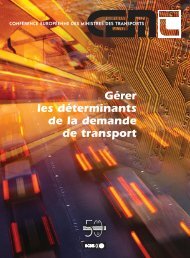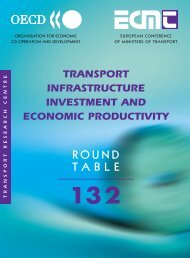Understanding the Value of Transport Infrastructure ...
Understanding the Value of Transport Infrastructure ...
Understanding the Value of Transport Infrastructure ...
You also want an ePaper? Increase the reach of your titles
YUMPU automatically turns print PDFs into web optimized ePapers that Google loves.
UNDERSTANDING THE VALUE OF TRANSPORT INFRASTRUCTURE<br />
2.2.2 The recording and measurement <strong>of</strong> capital stocks<br />
From an analytical perspective, it is interesting to also have data on <strong>the</strong> total capital<br />
stocks <strong>of</strong> transport infrastructure, both in monetary and physical terms. This section will<br />
only deal with <strong>the</strong> recording and measurement <strong>of</strong> stocks <strong>of</strong> assets, or capital stocks, in<br />
monetary terms. A lot <strong>of</strong> information exists on infrastructure capacity in physical terms.<br />
However, <strong>the</strong> challenge <strong>of</strong>ten is to include quality into measurement. For example, it is<br />
extremely difficult to have internationally comparable data on road infrastructure<br />
capacity at different service levels due to different standards in different countries. In<br />
principle, however, value <strong>of</strong> capital stock should reflect quality.<br />
According to <strong>the</strong> 2008 SNA, every item on <strong>the</strong> balance sheet has to be valued “… as if it<br />
were acquired on <strong>the</strong> date to which <strong>the</strong> balance sheet relates. This implies that when<br />
<strong>the</strong>y are exchanged on a market, assets and liabilities are to be valued using a set <strong>of</strong><br />
prices that are current on <strong>the</strong> date to which <strong>the</strong> balance sheet relates and that refer to<br />
specific assets” (SNA, para. 13.16). One has to take into account that <strong>the</strong> value <strong>of</strong> a<br />
certain asset will decrease while ageing and having been more used/depleted, as a<br />
consequence <strong>of</strong> which <strong>the</strong> future benefits that can be derived from such an asset will<br />
decrease as well.<br />
To adequately value assets using (equivalent) market prices, one would need prices from<br />
second-hand markets on which <strong>the</strong> items in question are regularly, actively and freely<br />
traded. This may be <strong>the</strong> case for e.g. cars and residential dwellings, but certainly not for<br />
transport infrastructure. In <strong>the</strong> absence <strong>of</strong> market equivalent prices for <strong>the</strong> relevant<br />
assets, two alternatives are available:<br />
1. Net present value method: <strong>the</strong> value <strong>of</strong> an asset is approximated by <strong>the</strong> present<br />
(discounted) value <strong>of</strong> future economic benefits expected from a given asset;<br />
2. Perpetual Inventory Method (PIM): <strong>the</strong> value <strong>of</strong> <strong>the</strong> capital stock is approximated<br />
by accumulating and revaluing acquisitions less disposals <strong>of</strong> <strong>the</strong> type <strong>of</strong> asset in<br />
question over its lifetime and adjusted for changes such as depreciation,<br />
destruction by natural disasters, etc.<br />
In compiling national accounts, <strong>the</strong> PIM usually is <strong>the</strong> preferred method. In <strong>the</strong> case <strong>of</strong><br />
transport infrastructure, it also seems <strong>the</strong> only viable method, given <strong>the</strong> absence <strong>of</strong><br />
market prices from trading in second-hand items, and given <strong>the</strong> difficulties in estimating<br />
<strong>the</strong> future benefits that can be derived from a particular asset. A major advantage <strong>of</strong> <strong>the</strong><br />
PIM is also that it basically resembles <strong>the</strong> “current replacement cost” or “depreciated<br />
replacement cost”, as <strong>of</strong>ten applied in business accounting, where one also <strong>of</strong>ten applies<br />
<strong>the</strong> historical cost method (before and after depreciation). The main difference between<br />
<strong>the</strong> two approaches relates to <strong>the</strong> prices at which <strong>the</strong> asset is valued. Whereas <strong>the</strong> first<br />
method tries to revalue <strong>the</strong> assets in question in line with present/current prices (<strong>of</strong>ten<br />
by using a general price index for <strong>the</strong> relevant asset), <strong>the</strong> second method retains <strong>the</strong><br />
valuation at <strong>the</strong> prices at which <strong>the</strong> assets in question were acquired in <strong>the</strong> past.<br />
© OECD/ITF 2013 13


